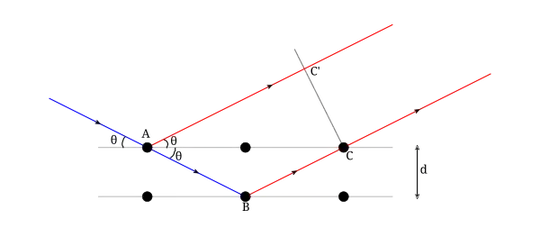It is a very common mistake to confuse the rays on a ray diagram with pencil-beams of light. They are not little pencil-beams; rather, they indicate the direction of travel of plane wavefronts.
When we treat interference effects such as from a grating or by reflection from a crystal, we are considering a given plane wave incident on the crystal from a given direction. Each wavefront is a plane orthogonal to the ray and extended 'sideways' from the ray, in principle out to infinite distance. So this means that two parallel rays separated from one another represent two plane waves that fully overlap.
The ray diagram is useful because the rays in fact track two important pieces of information:
- the direction of the ray indicates the direction in which a plane wave is travelling (already mentioned)
- the path along the ray indicates one path along which that plane wave accumulates phase as it goes.
The second piece of information is what we need in order to calculate the relative phase between the two overlapping plane waves at the 'output' side of the interferometer. Each wave picks up the total phase according to the path traveled by some given point on the wavefront. A wavefront is, by definition, a locus of places which all have the same phase.
To summarise: whenever you see a ray diagram used for interference calculations, draw some wavefronts onto the diagram if they have not been indicated. Either draw them neatly onto your book/lecture note, or just do it in your mind's eye, and keep in mind that these wavefronts are filling the space of the diagram.
In order to detect the interference effect, it is common practice either to place an output lens or mirror so as to focus the plane waves onto a detector, or else (e.g. for X rays) put the detector far enough away so that approximately plane waves (of finite spatial width) arrive at different places on the detector. This further information is not needed in order to calculate the interference effect, but sometimes people like to imagine the rays being not quite parallel and thus meeting on a detector a long way away. I would say that that picture does not help with an interference calculation for things like a grating or a crystal which have a wide aperture. It is clearer, I think, to let the output rays be exactly parallel and understand that they are telling you about overlapping plane waves.
